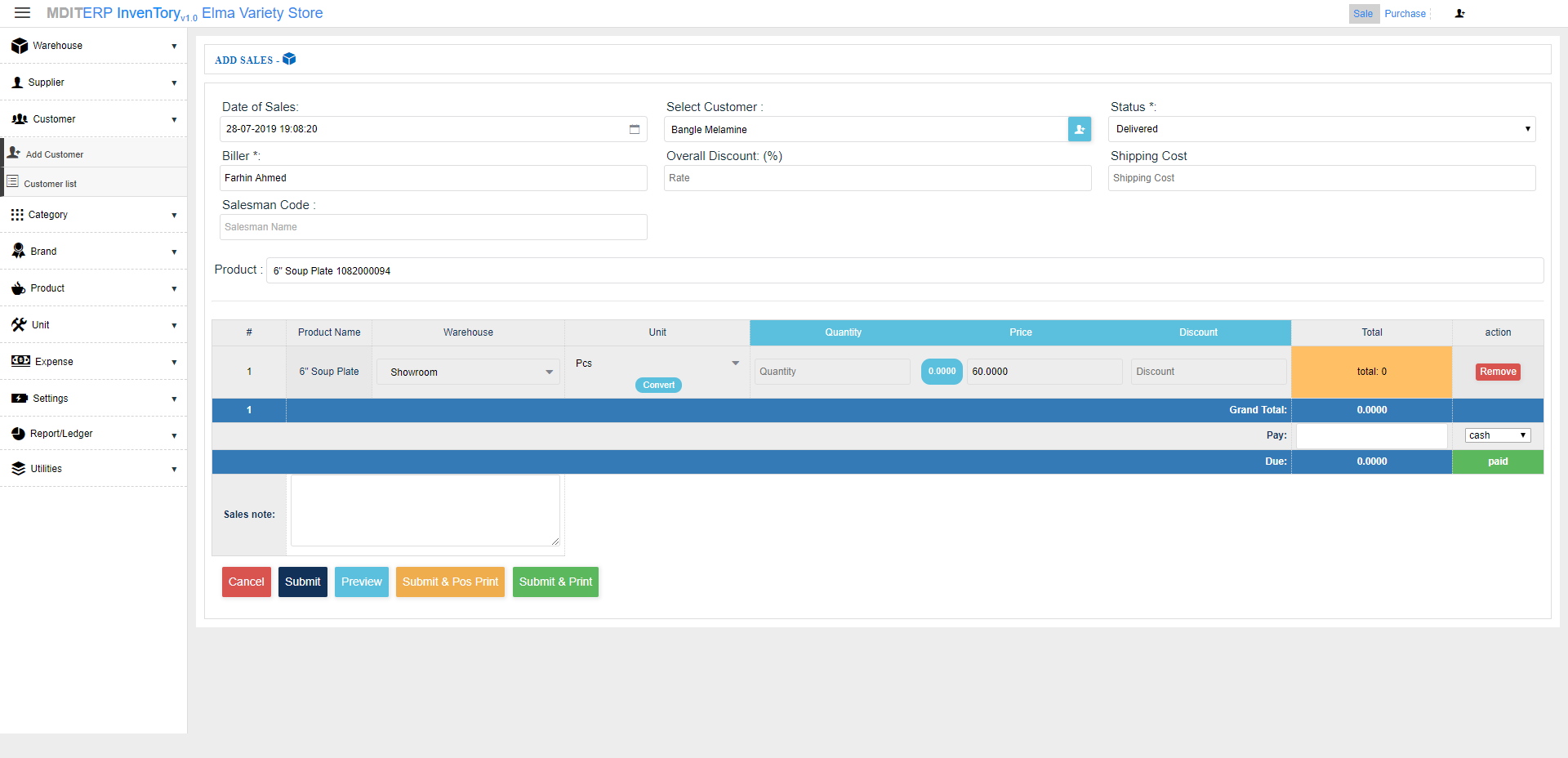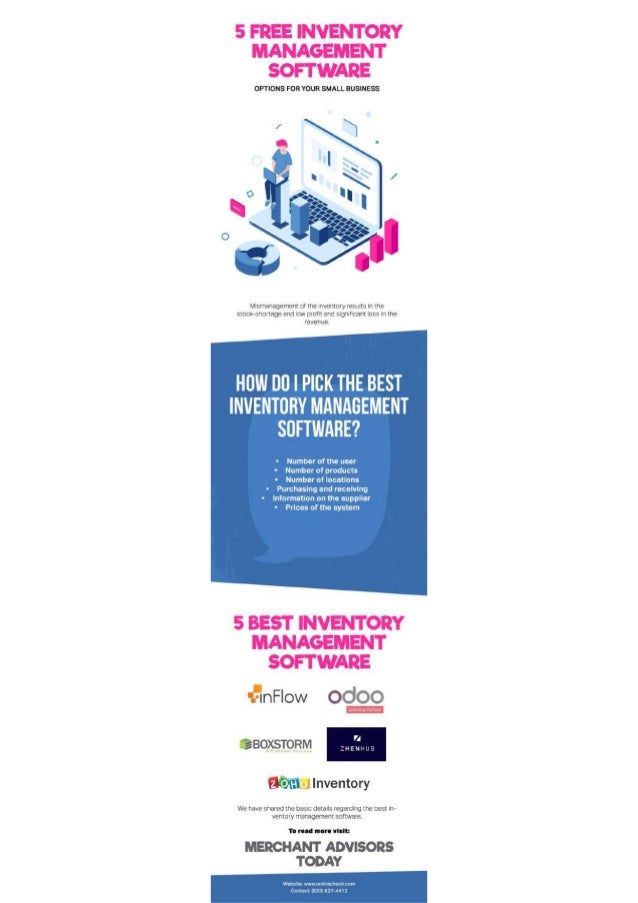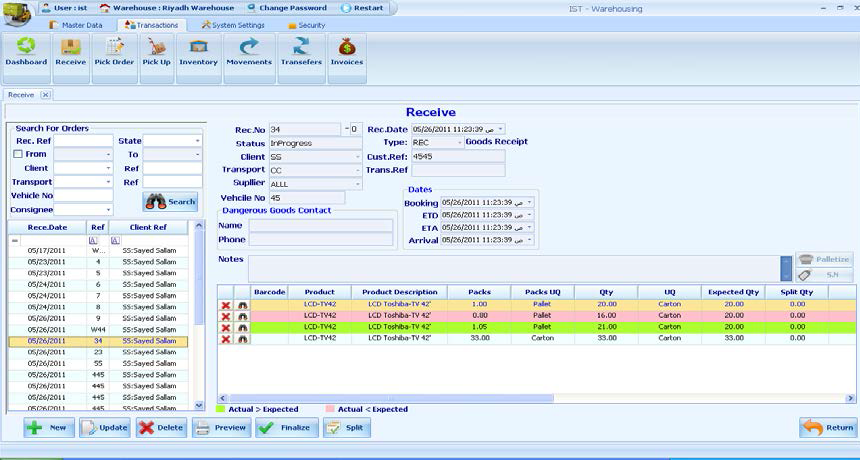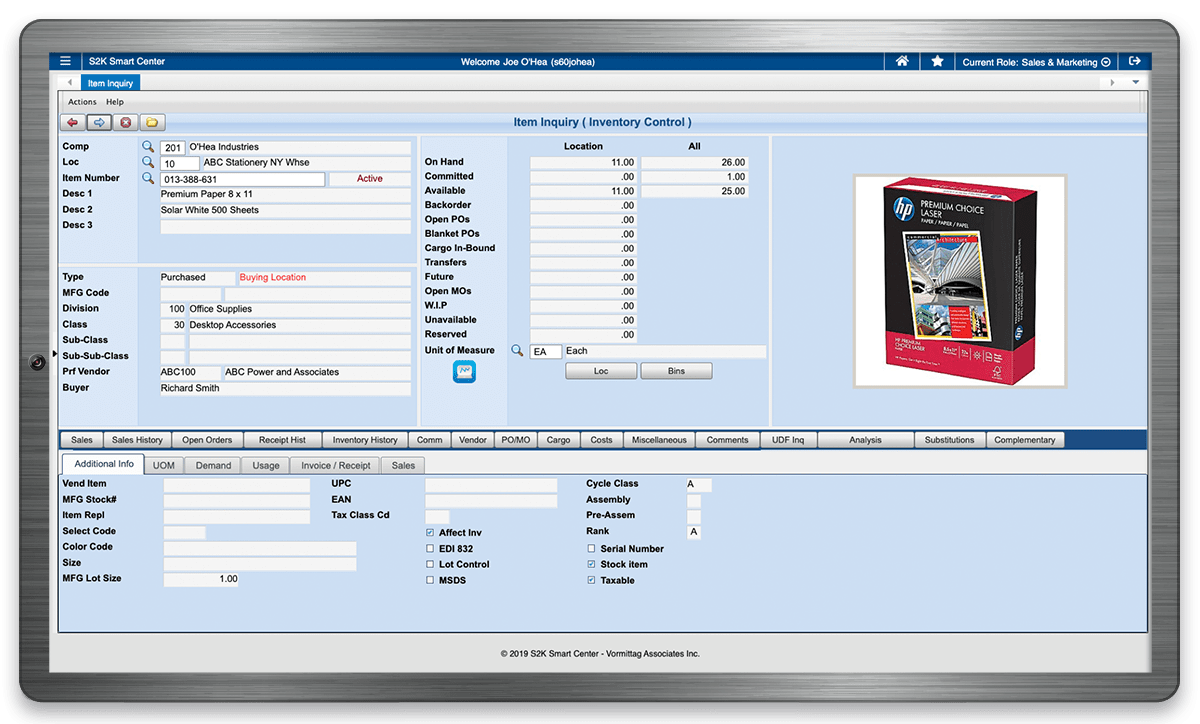Zoho Inventory is an online inventory management software that takes care of your inventory, purchase and sales orders, and warehouses. Sign up for free.
- Mobile App: This free inventory management software has a mobile app available as well. ABC Inventory; ABC Inventory is an absolutely free inventory management system in which you can add any number of products. The free inventory management software supports a single user and can be installed on many workstations.
- Zoho Inventory is a free inventory management software designed for growing businesses with little to invest financially in a software. The free solution provides more than just inventory control by also offering stock management and order fulfillment features.
Visibility, transparency, awareness, clarity, and forecasting. These are the key characteristics of IT administrators who successfully manage their IT estate by employing the discipline of IT asset management (ITAM).
Only a few years ago, the process of asset management was essentially a side task for most IT departments. But, nowadays, it’s become an essential part of IT service management. In fact, ITAM has been ranked as the fifth most adopted aspect of ITSM.
In addition, the management of IT assets has a direct impact on the top four ITSM processes; incidents, knowledge, change and problems.
This article will cover numerous practices and tips for improving the management of IT assets, such as:
ITAM in the modern business environment
The IAITAM (International Association of Information Technology Asset Managers) describes IT Asset Management as a set of business practices that incorporates IT assets across business units within an organisation. Its purpose is to join the financial, inventory, contractual, and risk management responsibilities to manage the overall life cycle of assets.
Organisational practices and industry trends from the past decade have increased the need for better asset management. Those include:
- The rise of Shadow IT, where non-IT executives adopt new solutions without going through the formal process
- The continual need to transform IT platforms, cloud migrations, and virtualisation
- Uncertainty around software license costs caused by virtualisation and migration to the cloud
- Increasing pressure to reduce costs while maintaining performance
- The increase in number of software audits
Even back in 2011, clients who successfully executed ITAM as a discipline have typically achieved a 30 per cent cost saving in the first year. As well as five per cent in the subsequent five years.
On the other hand, organisations who have not adopted ITAM or who have adopted it poorly are reported to spend 20 per cent of their total cost on software licensing and hardware maintenance for assets which are no longer used.
IT asset management typically differentiates between software asset management (SAM) and hardware asset management (HAM). SAM and HAM are two sides of the same coin. They need to be managed slightly differently as each one has specific requirements, but they are nonetheless interlinked.
In the early days, HAM came first and SAM second, as there had to be a physical infrastructure for software to reside on.
However, Hardware Asset Management is expensive and hard to maintain, which makes large investments in IT physical infrastructure for smaller businesses difficult to achieve.
Nowadays, large enterprises such as SAP, IBM, and Microsoft are bearing hardware infrastructure investment and operational costs. Offering the computing power and storage to their customers as services.
Serverless development takes this a step further, allowing one computer with an internet connection to seamlessly run complex functions.
As such, we’re starting to see a different distribution between hardware and software from organisation to organisation. Smaller businesses need less investment in hardware, while large organisations who provide Infrastructure as a Service, need to deploy more resources to meet demand.
Here we need to remember that most businesses have already made investments in IT infrastructure and are only expanding their IT capabilities by adopting a cloud solution. This is where complexity becomes an issue and asset management becomes crucial.
Almost 70 per cent of companies who have virtualised their software assets have failed vendor audits and ended up being charged large bills. Software audits are a heavy burden on IT resources, with ITAM teams having to spend 50 to 70 per cent of their time on dealing with audits.
Cost reduction is the main driver and the most obvious reason for adopting ITAM. But, there are many more benefits besides cost reduction:
- Increase procurement efficiency
- Improve compliance
- Increase asset and intellectual property security
- Reduce financial, contractual, and reputation risk
- Better position to negotiate new contracts
What to look for in IT Asset Management Tools
Fortunately, alongside the increasingly complex IT and networking systems, we’ve also developed tools that can help us optimise and improve an organisations’ asset collection.
The core capabilities of an IT Asset Management Tool are:
- Easy Data Import capabilities
- Repository to manage software and hardware assets
- Clearly defined relationship between IT Assets, Users, and usage information
- Integration with adjacent IT and business systems
The following functions for IT Asset Management tools can also be very useful:
- Audit Management
- Compliance Tracking
- Configuration Management
- Contract/License Management
- Cost Tracking
- Inventory Management
- Maintenance Management
- Procurement Management
- Requisition Management
- Supplier Management
What about using spreadsheets for ITAM?

While they might seem rudimentary and receive less marketing budget compared to dedicated ITAM tools, spreadsheets have plenty of functionality. This makes them suitable for small to medium IT estates.
In order to make the most of spreadsheet software, consider using the following functionalities:
Conditional formatting
This can be used to highlight assets going out of support, updates or the like.
Reporting
Using Microsoft Excel graphs or Pivot tables can produce complex reports.
Macros
Automate data processing and connect to external sources.
Data exporting and importing
Connect to SQL databases to feed or pull information.
Also Read: Why Good Spreadsheets Make Bad IT Asset Management Strategies »

In addition, most spreadsheet software is free and most IT systems already have a version of Microsoft Excel. So, there is no need for additional investment.
Best practices for managing hardware assets
Hardware is an umbrella term which includes most items that can be found in an IT environment. Examples include desktops, laptops, monitors, routers, switches, hubs, and phones.
The information stored against each hardware asset must at least ensure that the asset can be uniquely identified.
In order to optimize hardware assets, IT administrators need to keep additional information in regards to warranty, support contracts, maintenance, and other variables. Hardware asset management also needs to include data to support SAM.
Here is some core information for hardware:
- Asset name to create a unique identifier using information such as make, model, location
- Asset vendor
- Device types such as laptop, router, or mobile phone
- Serial number
- Asset statuses such as Deployed, In Storage, Retired and Disposed
- Asset roles such as Production, Standby, and Test
- The organisational entity that owns each asset
- Device location
- Configuration Information
- Software installed on the asset
- Purchase Date
- Go-Live Date
- Warranty / Contractual support Expiry Date
Inventory Management Software In Excel
When populating an ITAM tool’s database or a spreadsheet, IT administrators also need to add information about current IT assets. As well as setting up a process for adding new assets as they get acquired in the future.
How to add existing IT asset register data into a tool’s database

Below are described three ways in which IT administrators can populate a tool’s database with information about their current IT systems.
Import any existing trackers into the tool
If you have grown your business and a simple spreadsheet was enough to keep track of your hardware, you can use your spreadsheet to feed all the information into the HAM tool.
Discover your network for connected devices
There are plenty of discovery tools that are able to scan the entirety of your network and return plenty of information about your hardware assets.
Use supplier’s order information
Order details issued by the suppliers will give you information about all the assets in your estate.
Set up an IT asset tracking process for new items
Upon adding new IT assets in their estate, organisations go through a specific hardware lifecycle. The lifecycle outlines the steps through which the device progresses throughout its life.
Typically, a hardware lifecycle entails the following:
- Architecture and Network Design
- Request for asset
- Approval and Procurement
- Deployment
- Usage, maintenance, and upgrades
- Decommissioning

In a lifecycle such as the one described above, the asset tracking process starts as early as step number one. After performing analysis and putting forward a purchase order or business case for purchasing more assets, the IT department should already have a clear picture of which device will go where and what software it will need to run.
Inventory Programs Free
In step number four the asset management process can be consolidated when all data is available.
How to optimise IT assets using Hardware Asset Management
The benefits of using a hardware asset management tool stretch beyond simply storing device information. Modern tools allow you to configure your dashboard and access valuable information such as:
Generate reports
See the availability, usage, items not currently installed, devices to be decommissioned.
Use IT Network Monitoring to raise alarms
Raise issues when the software is going out of warranty or reaching its end of life.
Automate deployment workflows
Create configuration templates for devices depending on their functions.
Manage software and security updates
Schedule dedicated time slots for updates to minimize downtime.
Best practices for managing software assets
Managing software assets has become a necessity after the widespread implementation of cloud computing and the silent inclusion of Shadow IT.
Software asset management provides three benefits:
Governance
Ensuring that only approved applications are introduced into the local computing environment and the software licenses are fully and appropriately utilised.
Management
SAM provides multiple functions for scheduling updates, forecasting costs, adding new assets and decommissioning old ones.
Enterprise agility
The availability of information dramatically speeds up the change process in large organisations.
Licensing is arguably the most important dimension in regards to software asset management as poor handling of licenses can cost organisations in the millions.
There are many types of licenses, each with different contractual agreements and requirements. Some of those are:

Identity-locked
A license is assigned to a specific user and is non-commutable (e.g. Microsoft Windows).
Node-locked
A license which can only be used by one user at a time, but multiple users can use at subsequent times.
Floating
A license which is available to a large number of users. Upon login, a licensing system assigned the requesting user a license which is claimed back at the end of the session.
Site License
Unlimited usage on the site of the license installation.
Open Source
Unlimited usage within the licensing agreement.
Timed
License is only available for a set period of time.
Physically Restricted
Licenses attached to hardware.
Choosing a SAM tool
Software asset management tools are designed to offer IT personnel as much control and visibility over their IT estate. While each tool is different, most of them include functionalities such as:
- Software license management
- Software configuration
- Inventory management
- Software utilization
- Contract and purchasing
- Compliance ad governance
- Software lifecycle management
- Software deployment
- Reporting
When assessing the critical capabilities of software asset management tools, we recommend looking for characteristics which reconcile software entitlement and consumption data to reduce compliance risk, optimize costs and improve business performance. We recommend Infrastructure and operations leaders to look for the following:
- Software Entitlements Manual Entry
- Software Entitlements Automation
- Endpoint Software Consumption
- Data Center Software Consumption
- Cloud Consumption
- Speciality Software Consumption
- Reconcile External Information
- Optimize Entitlements/Consumption
- Share Information
How to manage software assets when employees join, leave, or move within the company
Whenever there is an organisational change, the employee in question will need to have an updated set of IT assets.
A workflow needs to be set up which should cover the following: assignment of existing assets, procurement of new assets, recovery of assets upon leaving the company, and also setting up a process for lost or stolen assets.
This IT workflow would need to work closely with the HR system, communicating between the information about the user and levels of permission.
How to manage software assets to prevent audits
Vendor audits are processes for investigating an organisation’ compliance for using the software within the contractual terms.
Poor visibility and management of available licenses can lead to an organisation being uncompliant, making it an easy target for vendors to up-sell their product and charge them large bills.
Large software vendors such as Microsoft, Adobe, IBM, SAP and Oracle have gained a reputation for aggressive software audits which disrupt an organisation’s IT operations.
Also Read: How to Prevent Software Licensing Audits »
By adopting a software asset management tool, the risk of becoming uncompliant is drastically reduced as IT administrators have an overarching view of all the available licenses, how they are distributed, who is using them, and when they are due to expire.
Keeping on top of license renewals, acquiring additional assets when demand increases and removing licenses in instances in which they are not used will help organisations not only protect themselves against being audited but also optimize their IT estate to produce most values.
Managing software assets when migrating to the cloud
Cloud migration is a complex and long project that can leave many holes in the IT systems if done incorrectly. Software asset management plays a huge role in ensuring that all users have access to the same services as before and there are no discrepancies between the system pre and post-migration.
Each vendor has slightly different systems, so there is a difference between SAP’s Hana Enterprise Cloud, IBM Cloud and even Adobe Experience Cloud.
Microsoft recommends IT leaders to consider SAM solutions that aid with the following:
- Helping determine whether on-premises, cloud, or hybrid is the best structure for the business.
- Mitigating risks associated with moving data centre assets for consolidation, cloud, and virtualization projects.
- Delivering a long-term cloud migration road map that helps define migration goals.
- Assessing whether migrating to the cloud will make it easier to manage software assets.
- Having an in-depth understanding of software licensing for both cloud and on-premises deployments.